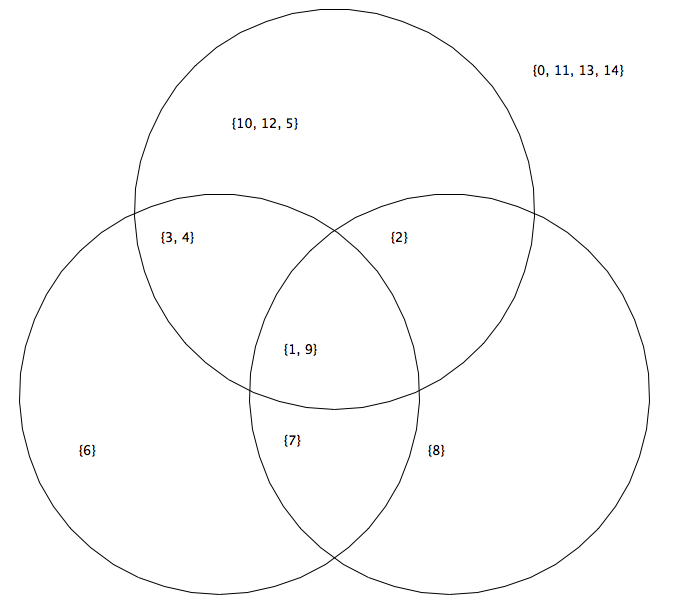T-SQL 2095
Assumes @N is an int containing N. Assumes @A, @B, and @C are tables containing the three sets of numbers. Didn't try to golf it too much.
DECLARE @D INT=@N,@E INT=0,@F CHAR='/',@G CHAR='\',@H CHAR='-',@I CHAR='|',@J CHAR='+'DECLARE @ TABLE(Z INT,Y INT,X INT,W INT,V INT,U INT,T INT,S INT)INSERT INTO @(Z)SELECT A.P FROM @A A JOIN @B B ON A.P=B.P JOIN @C C ON A.P=C.P INSERT INTO @(Y)SELECT A.P FROM @A A JOIN @B B ON A.P=B.P LEFT JOIN @C C ON A.P=C.P WHERE C.P IS NULL INSERT INTO @(X)SELECT C.P FROM @C C JOIN @A A ON C.P=A.P LEFT JOIN @B B ON C.P=B.P WHERE B.P IS NULL INSERT INTO @(W)SELECT B.P FROM @B B JOIN @C C ON B.P=C.P LEFT JOIN @A A ON B.P=A.P WHERE A.P IS NULL INSERT INTO @(V)SELECT A.P FROM @A A LEFT JOIN @B B ON A.P=B.P LEFT JOIN @C C ON A.P=C.P WHERE C.P IS NULL AND B.P IS NULL INSERT INTO @(U)SELECT C.P FROM @C C LEFT JOIN @A A ON C.P=A.P LEFT JOIN @B B ON C.P=B.P WHERE B.P IS NULL AND A.P IS NULL INSERT INTO @(T)SELECT B.P FROM @B B LEFT JOIN @C C ON B.P=C.P LEFT JOIN @A A ON B.P=A.P WHERE A.P IS NULL AND C.P IS NULL WHILE @N>=0BEGIN INSERT INTO @(S)SELECT @N WHERE @N NOT IN(SELECT*FROM @A UNION SELECT*FROM @B UNION SELECT*FROM @C)SET @N-=1 END DECLARE @Z TABLE(A CHAR(5),B CHAR(5),C CHAR(5),D CHAR(5),E CHAR(5),F CHAR(5),G CHAR(5),H CHAR(5))INSERT INTO @Z SELECT @F,@H,@F,@H,@G,@H,@G,''WHILE @E<=@D BEGIN INSERT INTO @Z SELECT @I,ISNULL((SELECT CONVERT(CHAR,@E,5) WHERE @E IN(SELECT V FROM @)),''),@I,ISNULL((SELECT CONVERT(CHAR,@E,5) WHERE @E IN(SELECT X FROM @)),''),@I,ISNULL((SELECT CONVERT(CHAR,@E,5) WHERE @E IN(SELECT U FROM @)),''),@I,ISNULL((SELECT CONVERT(CHAR,@E,5) WHERE @E IN(SELECT S FROM @)),'')SET @E+=1 END INSERT INTO @Z SELECT @F,@H,@J,@H,@G,'',@I,''SET @E=0WHILE @E<=@D BEGIN INSERT INTO @Z SELECT @I,ISNULL((SELECT CONVERT(CHAR,@E,5) WHERE @E IN(SELECT Y FROM @)),''),@I,ISNULL((SELECT CONVERT(CHAR,@E,5) WHERE @E IN(SELECT Z FROM @)),''),@I,'',@I,''SET @E+=1 END INSERT INTO @Z SELECT @G,@H,@J,@H,@F,'',@I,''SET @E=0WHILE @E<=@D BEGIN INSERT INTO @Z SELECT @I,ISNULL((SELECT CONVERT(CHAR,@E,5) WHERE @E IN(SELECT T FROM @)),''),@I,ISNULL((SELECT CONVERT(CHAR,@E,5) WHERE @E IN(SELECT W FROM @)),''),@I,'',@I,''SET @E+=1 END INSERT INTO @Z SELECT @G,@H,@G,@H,@F,@H,@F,''SELECT*FROM @Z
Less golfed version:
--finding the sets
DECLARE @D INT=@N,@E INT=0,@F CHAR='/',@G CHAR='\',@H CHAR='-',@I CHAR='|',@J CHAR='+'
DECLARE @ TABLE(Z INT,Y INT,X INT,W INT,V INT,U INT,T INT,S INT)
INSERT INTO @(Z)
SELECT A.P FROM @A A JOIN @B B ON A.P=B.P JOIN @C C ON A.P=C.P
INSERT INTO @(Y)
SELECT A.P FROM @A A JOIN @B B ON A.P=B.P LEFT JOIN @C C ON A.P=C.P WHERE C.P IS NULL
INSERT INTO @(X)
SELECT C.P FROM @C C JOIN @A A ON C.P=A.P LEFT JOIN @B B ON C.P=B.P WHERE B.P IS NULL
INSERT INTO @(W)
SELECT B.P FROM @B B JOIN @C C ON B.P=C.P LEFT JOIN @A A ON B.P=A.P WHERE A.P IS NULL
INSERT INTO @(V)
SELECT A.P FROM @A A LEFT JOIN @B B ON A.P=B.P LEFT JOIN @C C ON A.P=C.P WHERE C.P IS NULL AND B.P IS NULL
INSERT INTO @(U)
SELECT C.P FROM @C C LEFT JOIN @A A ON C.P=A.P LEFT JOIN @B B ON C.P=B.P WHERE B.P IS NULL AND A.P IS NULL
INSERT INTO @(T)
SELECT B.P FROM @B B LEFT JOIN @C C ON B.P=C.P LEFT JOIN @A A ON B.P=A.P WHERE A.P IS NULL AND C.P IS NULL
WHILE @N>=0
BEGIN
INSERT INTO @(S)
SELECT @N WHERE @N NOT IN(SELECT*FROM @A UNION SELECT*FROM @B UNION SELECT*FROM @C)
SET @N-=1
END
--displaying the venn diagram
DECLARE @Z TABLE(A CHAR(5),B CHAR(5),C CHAR(5),D CHAR(5),E CHAR(5),F CHAR(5),G CHAR(5),H CHAR(5))
INSERT INTO @Z
SELECT @F,@H,@F,@H,@G,@H,@G,''
WHILE @E<=@D
BEGIN
INSERT INTO @Z
SELECT @I,ISNULL((SELECT CONVERT(CHAR,@E,5) WHERE @E IN(SELECT V FROM @)),''),@I,ISNULL((SELECT CONVERT(CHAR,@E,5) WHERE @E IN(SELECT X FROM @)),''),@I,ISNULL((SELECT CONVERT(CHAR,@E,5) WHERE @E IN(SELECT U FROM @)),''),@I,ISNULL((SELECT CONVERT(CHAR,@E,5) WHERE @E IN(SELECT S FROM @)),'')
SET @E+=1
END
INSERT INTO @Z
SELECT @F,@H,@J,@H,@G,'',@I,''
SET @E=0
WHILE @E<=@D
BEGIN
INSERT INTO @Z
SELECT @I,ISNULL((SELECT CONVERT(CHAR,@E,5) WHERE @E IN(SELECT Y FROM @)),''),@I,ISNULL((SELECT CONVERT(CHAR,@E,5) WHERE @E IN(SELECT Z FROM @)),''),@I,'',@I,''
SET @E+=1
END
INSERT INTO @Z
SELECT @G,@H,@J,@H,@F,'',@I,''
SET @E=0
WHILE @E<=@D
BEGIN
INSERT INTO @Z
SELECT @I,ISNULL((SELECT CONVERT(CHAR,@E,5) WHERE @E IN(SELECT T FROM @)),''),@I,ISNULL((SELECT CONVERT(CHAR,@E,5) WHERE @E IN(SELECT W FROM @)),''),@I,'',@I,''
SET @E+=1
END
INSERT INTO @Z
SELECT @G,@H,@G,@H,@F,@H,@F,''
SELECT*FROM @Z







